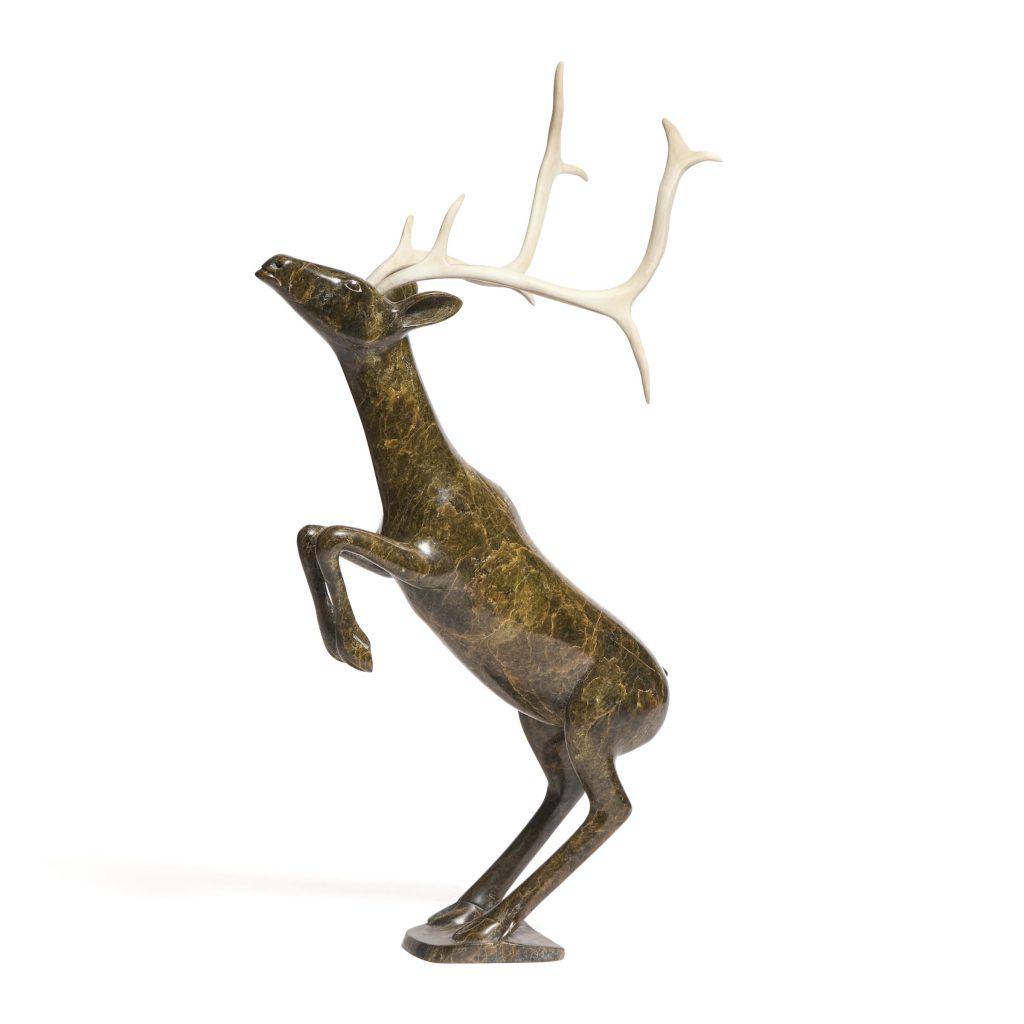
All of Osuitok’s caribou are feats of engineering, but none more so than the gracefully rearing iterations, of which this is one. They are extreme examples of balance and precision, their gravity-defying compositions perfectly able to express the elegance of the caribou. Though the base of this sculpture looks miniscule in proportion to the large body above, this is a particularly stable and finely carved example.
Through the 1950s and later, Osuitok was his community’s “keeper of the carving stone,” leading the expeditions to quarry materials in the summer months when the ground had thawed sufficiently. In guiding other artists when selecting stone, he came to understand the way the material fractures and breaks. That intimate knowledge of the stone assisted him in his ability to carve his caribou with finesse and equilibrium.
Of his process Osuitok explained:
“When I’m doing a caribou, I first make the outline of the animal starting with the muzzle, the nose, and then I work my way down to the body. Then I work on the leg areas. The standing caribou are more difficult than the kneeling ones. I work with files when I am doing the legs and ears. The ears are the last thing I do because they tend to break off. So I finish with those.
I don’t use the grinder to make the form because sometimes there are areas that you tend to cut into too deeply, something you’re not supposed to do. I prefer to use an axe and a saw. Also I use files that you use for steel (rasps) and then I switch to files for the finer work.
For balancing I make sure the base is smooth and flat so that the caribou doesn’t tip to the front or side.
I just make sure that the bottom of the hooves is perfectly level. I use a level like carpenters use in construction work. I make sure the base is a little bit thick before I start to get it level.” (1)
ABOUT THE AUCTION
Held online from May 24-29, 2024, Waddington’s is pleased to present our major spring auction of exceptional Inuit & First Nations Art. Important artworks this season include works of sculpture and graphics by Karoo Ashevak, Jessie Oonark, Kiakshuk, John Pangnark, Pauta Saila, Aisa Qupirualu Alasua, Parr, Osuitok Ipeelee, Kiugak Ashoona, Joe Talirunili, John Kavik, Kenojuak Ashevak, Johnny Inukpuk, Thomas Ugjuk, Ennutsiak, Davidialuk Alasua Amittu, Beau Dick, Charlie James, David Ruben Piqtoukun, Abraham Apakark Anghik, Manasie Akpaliapik, Judas Ullulaq, Barnabus Arnasungaaq, and John Tiktak.
Previews will be available at our Toronto gallery, located at 275 King Street East, Second Floor, Toronto:
Thursday, May 23 from 10 am to 5 pm
Friday, May 24 from 10 am to 5 pm
Saturday, May 25 from 12 pm to 4 pm
Sunday, May 26 from 12 pm to 4 pm
Monday, May 27 from 10 am to 5 pm
Tuesday, May 28 from 10 am to 5 pm
Or by appointment.
Please contact us for more information.
(1) Susan Gustavison, Northern Rock Contemporary Inuit Stone Sculpture (Kleinburg: McMichael Canadian Art Collection, 1999), 64.


